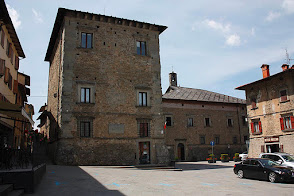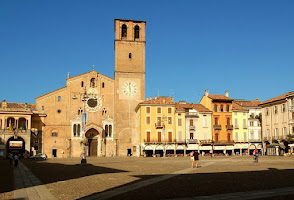‘Virtuoso of the left hand’ had brief but influential career
The pianist and composer Adolfo Fumagalli, who is chiefly remembered for his extraordinary ability to play complicated pieces with only his left hand, was born on this day in 1828 in Inzago, a small town about 28km (17 miles) east of Milan.
Adolfo Fumagalli was hailed as a 'first-rate'
pianist by Hungarian great Franz Liszt
Born into a family rich in musical talent, Fumagalli became known at a young age for his technical prowess and expressive style, a dazzling performer playing in the conventional two-handed fashion.
He studied piano at the Milan Conservatory from the age of nine to 19. It is noted that, as a 12 or 13-year-old, his performance playing variations on a march from Gioachino Rossini 's opera L'assedio di Corinto in the Conservatory hall created excitement.
Fumagalli made his public debut in Milan in 1848, at the age of 20. His talent was greeted with enthusiastic acclaim and he was soon captivating audiences across Europe at recitals in Turin, Paris, Belgium and Denmark. A letter written in 1853 by the great Hungarian composer Franz Liszt, described Fumagalli as a 'first-rate' pianist.
His switch to playing with one hand came not out of necessity, as was the case, for example, with the Austrian-born virtuoso Paul Wittgenstein after losing his right arm during World War One, but as part of a Romantic-era tradition among pianists to dazzle audiences with feats of technical brilliance.
Fumagalli saw playing with his left hand only as a daring artistic challenge to push the boundaries of what could be achieved with a single hand on the keyboard.
He composed pieces of his own but it was for his adaptation - for the left-hand only - of existing pieces that he became widely known and admired.
Of these so-called fantasie - fantasies - perhaps his most famous work, the “Grande Fantaisie sur Robert le Diable” by Meyerbeer, became a benchmark of virtuosity.
 |
| Fumagalli in caricature, smoking a cigar while playing left-handed |
In fact, apart from showcasing his technical ingenuity and staggering dexterity, he left an important legacy, having demonstrated for the benefit of aspiring pianists with injuries or other limitations that their handicaps could be overcome.
Other notable pieces in Fumagalli’s repertoire included operatic fantasies on Vincenzo Bellini’s Norma, Gaetano Donizetti’s Lucia di Lammermoor, and Giuseppe Verdi’s I Puritani, which critics applauded for his imaginative reworking and interpretive depth.
Fumagalli, whose brothers Carlo, Disma, Polibio, and Luca also became accomplished musicians and composers, would almost certainly have enjoyed a long career playing before audiences around the world had he been blessed with better health.
However, after returning to Italy in 1854 following a period on tour, he developed tuberculosis and his health began to falter markedly. He continued to perform but on May 3, 1856, just two days after he had given a concert in Florence, he died.
He was just 27 years old and his death shocked the musical world, cutting short a career that many believed was on the cusp of greatness.
Much of Fumagalli’s work has been lost but some pieces exist. Ferruccio Busoni, an Italian pianist popular in Europe and America in the late 19th and early 20th centuries, included some of Fumagalli’s works in his active repertoire.
More recently, the Milanese pianist Adalberto Maria Riva has revived interest in Fumagalli’s music through both recordings and performances.
Travel tip:The sumptuous Villa Rey is one of several villas
lining the banks of the Martesana Canal in Inzago
With a population of around 11,000 today, Inzago is perhaps three times the size it was at the time of Adolfo Fumagalli’s birth, when it was a small town halfway between Milan and Bergamo surrounded by farmland. Today it is part of the Milan metropolitan area, although some 28km (11 miles) from the centre of the Lombardy capital. Its farming roots are still strong and a cattle fair is held in the town every Monday. The town is divided in two by the Martesana Canal, which has a number of elegant villas – once the summer residences of noble Milanese families – along its banks. Many of these have returned to their former splendour in recent decades thanks to some private individuals who have renovated them. Among the most notable are Villa Aitelli, Villa Magistretti, Villa Rey and Villa Facheris.
Stay in Inzago with Expedia
Travel tip:
The historic Milan Conservatory boasts an impressive
roll call of celebrated former pupils
The Milan Conservatory - also known as Conservatorio di musica “Giuseppe Verdi” di Milano - was established by a royal decree of 1807 in Milan, capital of the Napoleonic Kingdom of Italy. It opened the following year with premises in the cloisters of the Baroque church of Santa Maria della Passione in Via Conservatorio. Though Verdi famously failed his entrance exam here in 1832, the conservatory was later named in his honour, reflecting his towering influence on Italian music. By the 19th century, the conservatory had become a hub for public performances and contemporary music programs, embracing both tradition and innovation. More recently, it has become the first Italian conservatory to offer education across all musical languages, from classical to jazz and experimental forms. The largest institute of musical education in Italy, its alumni as well as Adolfo Fumagalli include Giacomo Puccini, Amilcare Ponchielli, Arrigo Boito, Pietro Mascagni, Riccardo Muti and Ludovico Einaudi.
Find accommodation in Milan with Hotels.com
More reading:
The 19th century violin virtuoso considered to be Paganini’s successor
Giuseppe Verdi, the composer who became a national symbol
The Italian jazz pianist who learned at the feet of American greats
Also on this day:
1882: The birth of Futurist painter Umberto Boccioni
1956: The birth of Carlo Urbani, the microbiologist who identified SARS virus
2012: The death of three-times Giro d’Italia champion Fiorenzo Magni









.jpg)

.jpg)
.jpg)
























